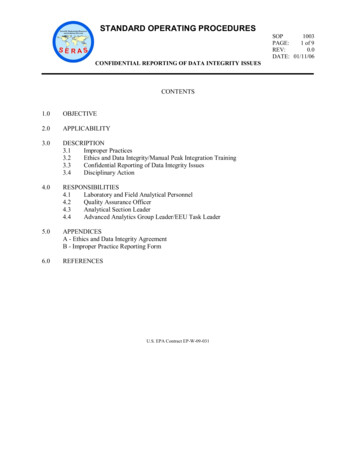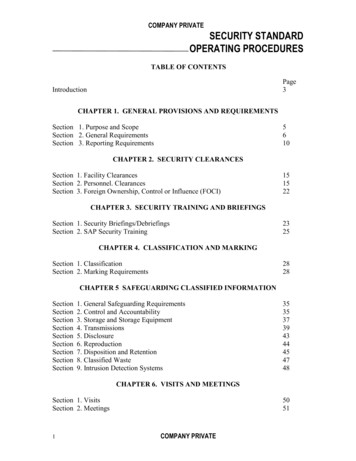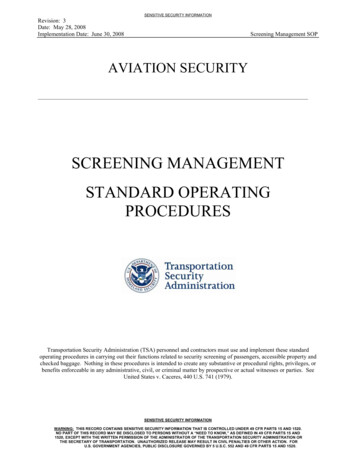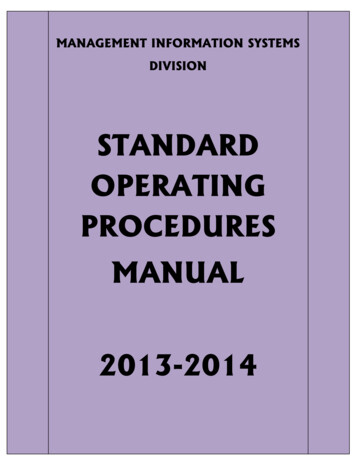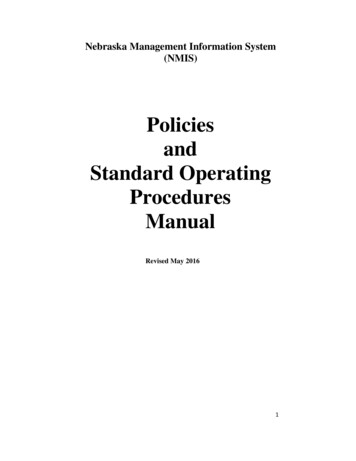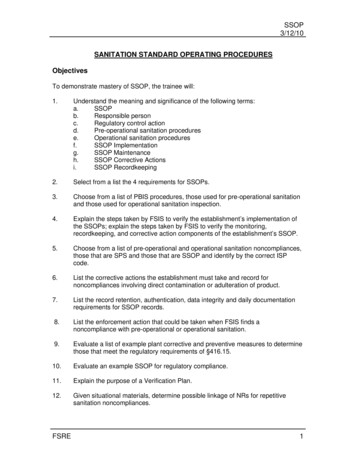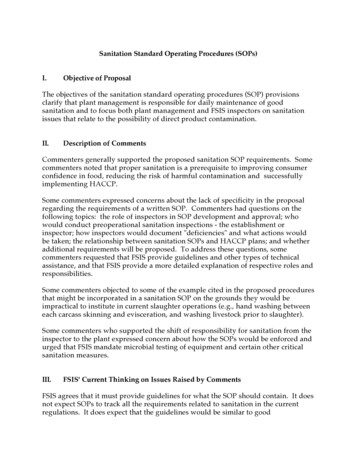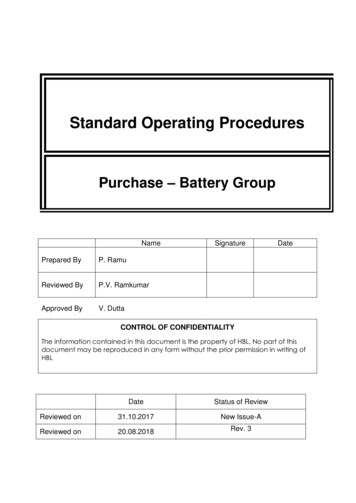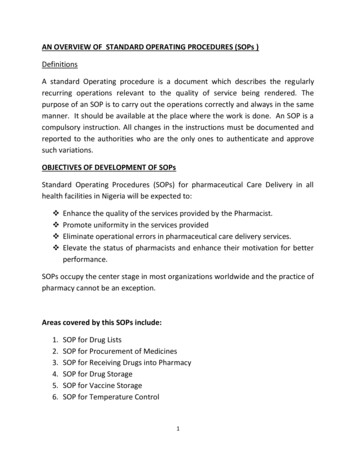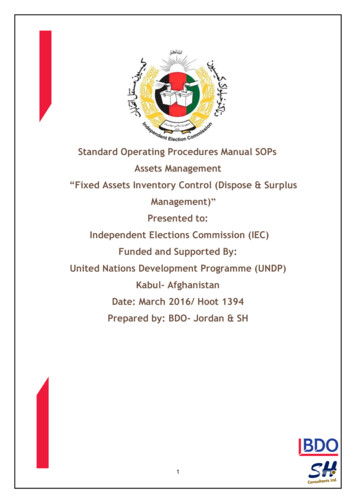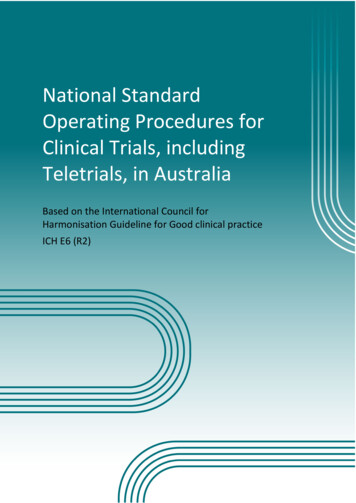
Transcription
National StandardOperating Procedures forClinical Trials, includingTeletrials, in AustraliaBased on the International Council forHarmonisation Guideline for Good clinical practiceICH E6 (R2)Department of Health - Insert Factsheet title1
Copyright 2020 Clinical Trials Project Reference GroupThis work is copyright. You may copy, print, download, display and reproduce the whole orpart of this work in unaltered form for your own personal use or, if you are part of anorganisation, for internal use within your organisation, but only if you or your organisation:a) do not use the copy or reproduction for any commercial purpose; andb) retain this copyright notice and all disclaimer notices as part of that copy or reproduction.Apart from rights as permitted by the Copyright Act 1968 (Cth) or allowed by this copyrightnotice, all other rights are reserved, including (but not limited to) all commercial rights.Requests and inquiries concerning reproduction and other rights to use are to be sent to theCommunication Branch, Commonwealth Department of Health, GPO Box 9848, CanberraACT 2601, or via e-mail to copyright@health.gov.au.AcknowledgementThe Commonwealth Department of Health gratefully acknowledges the NMA WorkingGroup, the Queensland Department of Health, the NSW Ministry of Health and expertstakeholders for their efforts, assistance and contributions in progressing this importantwork. All jurisdictions also acknowledge Roberta Lusa (Principal Policy Officer QueenslandClinical Trials Coordination Unit) and Tanya Symons (Consultant Technical Writer to NSW),for their expertise and commitment in developing key technical documents within individualjurisdictions, and on which much of the National Teletrials Compendium is based.National Standard Operating Procedures for Clinical Trials, including Teletrials in Australia2
ContentsIntroduction. 5Glossary . 7Terms . 10SOP 01 Creation, Implementation and Revision of Standard Operating Procedures. 24SOP 02 Investigator Responsibilities . 26SOP 03 Site Staff Qualifications, Training Records and Capability. 29SOP 04 Protocol and Investigational Brochure Requirements . 34SOP 05 Communication with HREC, RGO, Sponsor and Institution’s Insurer . 37SOP 06 Site Initiation . 42SOP 07 The Study Master File . 44SOP 08 Case Report Forms and Source Documents . 47SOP 09 Participant Informed Consent Process and Documentation . 49SOP 10 Handling and Shipping of Biological Substances (Cat B) and Dangerous Goods . 54SOP 11 Management of Investigational Product . 56SOP 12 Safety Data Monitoring and Reporting Requirements for Clinical Trials . 59SOP 13 Site Close-Out and Archiving . 65Appendix 1 SOP Template . 67Appendix 2 Example of a CV . 68Appendix 3 Training Record . 69Appendix 4 Delegation Log . 71Appendix 5 Supervision Plan . 72Appendix 6 Protocol Deviation Log Example . 85Appendix 7 Initiation Checklist Example . 87Appendix 8 Study Master File Index with document location Example . 90Appendix 9 Individual Participant Investigational Product (IP) Accountability RecordExample . 98Appendix 10 Bulk Investigational Product Accountability Log Example . 99Appendix 11 Sponsor Reporting of SUSAR and USADEs to TGA (for trials conducted underthe CTN or CTA schemes) . 101Appendix 12 Safety Reporting Assessment Flowchart Investigational Medicinal ProductTrials . 102Appendix 13 Report Flowchart for Investigation Medicinal Product Trials . 103National Standard Operating Procedures for Clinical Trials, including Teletrials in Australia3
Appendix 14 Safety Reporting Assessment Flowchart Investigational Medicinal DeviceTrials . 104Appendix 15 Report Flowchart for Investigational Medicinal Device Trials . 105Appendix 16 Close-Out Checklist Example. 106Appendix 17 Jurisdictional Contact Details . 107National Standard Operating Procedures for Clinical Trials, including Teletrials in Australia4
IntroductionThese National Standard Operating Procedures for Clinical Trials, including Teletrials havebeen developed to assist organisations engaged in conducting clinical trials in Australia to,wherever possible, standardise their procedures for key operations related to clinical trialsand specifically teletrials. They have been developed for the National Mutual Acceptance(NMA) Scheme in Australia and to support a consistent approach to national implementationmore broadly. They have been endorsed by all states and territories, together with theTherapeutic Goods Administration (TGA) and the National Health and Medical ResearchCouncil (NHMRC), through the Clinical Trials Project Reference Group (CTPRG).The National Standard Operating Procedures for Clinical Trials, including Teletrials, form partof a Teletrials Compendium, developed to support a consistent national approach toimplementation of teletrials in Australia, which includes: the National Principles for Teletrials in Australia, and the National Standard Operating Procedures for Clinical Trials, including Teletrials.The documents within the Teletrials Compendium are consistent with minimum standardimposed by the International Council for Harmonisation (ICH) Guideline for Good ClinicalPractice E6 (R2) - an international ethical and scientific quality standard for the design,conduct, performance, monitoring, auditing, recording, analyses and reporting of clinicaltrials that involve participation of humans - and comply with the Integrated Addendum tothis Guideline published by the TGA.Compliance with the Teletrials Compendium provides public assurance that the rights, safetyand well-being of trial participants are protected, consistent with the principles that havetheir origin in the Declaration of Helsinki, and that the clinical trial data generated from theclinical trials are credible. These guidelines are also intended to conform with the UniversalDeclaration on Bioethics and Human Rights, which seeks to address ethical issues related tomedicine, life sciences and associated technologies as applied to human beings, taking intoaccount their social, legal and environmental dimensions, and to provide guidance todecisions or practices of individuals, groups, communities, Institutions and corporations,public and private.The Teletrials Compendium is consistent with the National Statement on the Ethical Conductin Human Research 2007 (Updated 2018), and also aligns with the Clinical Trials GovernanceFramework which has been designed to support the delivery and integration of high-qualityclinical trials service provision into routine hospital care for improved patient outcomes.These National Principles for Teletrials are also consistent with recommendations from theClinical Oncology Society of Australia’s (COSA) Australasian Teletrial Model – A NationalGuide to Implementation, September 2016.These Standard Operating Procedures as described in this document apply to all healthservice employees including, but not limited to, visiting health professionals, contractors,consultants and volunteers who propose to undertake, administrate, review and/or governhuman research involving patients/participants, facilities and or staff. It is understood thatall study personnel involved in the clinical study must operate within their scope of practice.In accordance with best practice, the Standard Operating Procedures will be subject to aregular review every two years.National Standard Operating Procedures for Clinical Trials, including Teletrials in Australia5
NMA is a national initiative for mutual acceptance of ethical and scientific review in publichospitals for multi-centre clinical trials and research.The CTPRG, formerly the Clinical Trials Jurisdictional Working Group (CTJWG), wasestablished in July 2014 and involves senior officials from Commonwealth, State andTerritory health departments, and the NHMRC. The CTPRG seeks to identify and implementactions and system redesign that will enable a streamlined and consistent national approachto clinical trials within Australia with the intention of enhancing health outcomes andbuilding Australia’s ability to attract national and international clinical trials. Delivery of aframework to support national implementation of the Teletrials Model is a key deliverableidentified on the CTPRG Implementation Plan.NOTE: Refer to these Glossary and Terms sections for clarification of all relevant definitionsand acronyms used throughout this document and the Teletrials Compendium.National Standard Operating Procedures for Clinical Trials, including Teletrials in Australia6
GlossaryTERMDESCRIPTIONADEAdverse Device EffectADRAdverse Drug ReactionAEAdverse EventAHPRAAustralian Health Practitioner Regulation AgencyAIAssociate InvestigatorARPANSAAustralian Radiation Protection and Nuclear Safety AgencyARPANSACode ofPracticeARPANSA Code of Practice for the Exposure of Humans to IonizingRadiation for ResearchCAPACorrective and Preventative ActionsCASACivil Aviation Safety AuthorityCIOMSCouncil for International Organizations of Medical SciencesCPICoordinating Principal InvestigatorCRAClinical Research AssociateCRCClinical Research CoordinatorCRFCase Report FormCROContract Research OrganisationCTAClinical Trial Approval scheme (previously Clinical Trials Exemption (CTX)scheme)CTNClinical Trial Notification schemeCTPRGClinical Trials Project Reference GroupCTRAClinical Trial Research AgreementCVCurriculum VitaeDSMBData and Safety Monitoring BoardEMRElectronic Medical RecordNational Standard Operating Procedures for Clinical Trials, including Teletrials in Australia7
TERMDESCRIPTIONGCPGood Clinical PracticeHHSHospital and Health ServiceHRECHuman Research Ethics CommitteeIATAInternational Air Transport AssociationICHInternational Council for Harmonisation of Technical Requirements ofPharmaceuticals for Human UseIPInvestigational ProductIMDInvestigational Medicinal DeviceIMPInvestigational Medicinal ProductIVRSInteractive Voice Response SystemIWRSInteractive Web Response SystemNationalStatementNational Statement on Ethical Conduct in Human Research (NHMRC)NHMRCNational Health and Medical Research CouncilNMANational Mutual AcceptancePIPrincipal InvestigatorPICFParticipant Information and Consent FormPMSPost Registration or Marketing Surveillance StudyRGOResearch Governance OfficerSADESerious Adverse Device EffectSAESerious Adverse EventSMFStudy Master FileSSA FormSite Specific Assessment FormSSISignificant Safety IssueSSSFSatellite Site Study FileNational Standard Operating Procedures for Clinical Trials, including Teletrials in Australia8
TERMDESCRIPTIONSUSARSuspected Unexpected Serious Adverse ReactionTGATherapeutic Goods AdministrationURUnit RecordUSADEUnanticipated Serious Adverse Device EventUSMUrgent Safety MeasureNational Standard Operating Procedures for Clinical Trials, including Teletrials in Australia9
TermsPlease refer to terms in this section when reading the National Standard Operating Procedures forClinical Trials, including Teletrials, in Australia and other associated documents.Adverse Device Effect (ADE)Adverse event related to the use of anInvestigational Medical Device.Note: This definition includes adverse eventsresulting from insufficient or inadequateinstructions for use, deployment,implantation, installation, or operation, or anymalfunction of the Investigational MedicalDevice. This definition includes any eventresulting from use error or from intentionalmisuse of the Investigational Medical Device.Any individual member of the clinical trialteam designated and supervised by thePrincipal Investigator at a trial site to performcritical trial related procedures and/or tomake important trial related decisions e.g.associates, residents, research fellows.Where the Teletrial Model is implemented: Adverse Drug Reaction (ADR)Any untoward and unintended response to anInvestigational Medicinal Product or devicerelated to any dose administered. All adverseevents judged by either the reportingInvestigator or the Sponsor as having areasonable possibility of a causal relationshipto an Investigational Medicinal Product ordevice, would qualify as adverse reactions.The expression “reasonable possibility of acausal relationship” means to convey ingeneral that there is evidence or argument tosuggest a causal relationship.Adverse Event (AE)In the Australian context, an adverse event(AE) is any unfavourable and unintended sign(including an abnormal laboratory finding),symptom or disease temporally associatedwith the use of a medicinal product, whetheror not considered related to the medicinalproduct. An adverse event is an incident thatresults, or could have resulted, in harm to apatient/participant or consumer. Anunintended near miss is a type of adverseevent.ARPANSA Code of Practice for the Exposureof Humans to Ionizing Radiation for ResearchPurposes (2005)See Code of Practice An AI when located at a Primary Sitemay be delegated some or all of thestudy related activities by the PIaccording to their level of experienceand documented in the DelegationLog.An AI when located at the SatelliteSite is the local contact for studyrelated matters at the Satellite Siteand will be under the supervision ofthe PI at the Primary Site.AuditAn audit is a systematic and independentexamination of trial activities to determinewhether a trial is conducted in accordancewith applicable requirements. May bescheduled periodically at sites to confirmProtocol compliance and adherence to GCPand regulatory requirements. Routine auditsoften involve an opening meeting and areconducted according to a pre-prepared plan,which may be revised based on initial findingsas the audit proceeds. Audits normally includeinterviews with the trial team, supportingdepartment staff and the research office,document review, and facility tours.Australian Health Practitioner RegulationAgency (AHPRA)Working with 15 National HealthPractitioner Boards, the Australian HealthPractitioner Regulation Agency (AHPRA) isthe national organisation responsible forimplementing the National RegistrationAssociate Investigator (AI)National Standard Operating Procedures for Clinical Trials, including Teletrials in Australia10
and Accreditation Scheme (the NationalScheme) across Australia.Australian Radiation Protection and NuclearSafety Agency (ARPANSA)The Australian Radiation Protection andNuclear Safety Agency (ARPANSA) is theAustralian Government's primary authority onradiation protection and nuclear safety.ARPANSA regulates Commonwealth entitiesusing radiation with the objective ofprotecting people and the environment fromthe harmful effect of radiation.Blue CardAn Adverse Reaction reporting form to reportsuspected adverse reactions to vaccines andprescription, over-the-counter andcomplementary medicines to the TherapeuticGoods Administration.Case Report Form (CRF and e-CRF)A printed, optical, or electronic documentdesigned to record all of the Protocol requiredinformation to be reported to the studySponsor on each trial participant. The datacollected in the CRF is used as the basis of thetrial report and any publications, as well asmaking up part of the data for regulatoryapproval for the unapproved therapeuticgoods.Certified copyA certified copy is a copy of an originaldocument that has been verified to be a truecopy of the original document by anauthorised witness after they have sighted theoriginal document.Civil Aviation Safety Authority (CASA)TrainingPart 92 of the Civil Aviation Safety Regulation(CASR) prescribes the minimum safetyrequirements for the consignment andcarriage of dangerous goods by air. It includestraining, documentation, record keeping andincident reporting as well as provisions forpackaging, marking, labelling, loading of andstowage in aircraft. Staff involved in thepreparation, safe handling and carriage ofdangerous goods on aircraft, are required toundertake CASR Part 92 training.Clinical Research Associate (CRA)An individual designated by a Sponsor orContract Research Organisation (CRO) tomonitor the sites conduct in a clinical trial.Clinical Research Coordinator (CRC)/ ClinicalTrial Coordinator (CTC)A research worker who works at a clinicalresearch site under the immediate directionof a Principal Investigator, whose researchactivities are conducted in accordance withGood Clinical Practice guidelines, the NationalStatement, and the National Clinical TrialsGovernance Framework. May also be called“Clinical Study Coordinator” or “TrialCoordinator” or “Research Coordinator” or“Research Nurse”.Where Teletrials is engaged, the CRC at thePrimary Site is the contact for coordinators atboth Primary and Satellite Sites. Their dutiesare extended to include Satellite Sites in allaspects of their role (these roles can bedelegated to Satellite Site coordinators).Clinical Trial AgreementSee Clinical Trial Research Agreement.Clinical Trial Approval (CTA) scheme (previously Clinical Trials Exemption (CTX)scheme)The CTA scheme is established under theTherapeutic Goods Act 1989 (Cth) and isadministered by the TGA. Under the CTAscheme, therapeutic goods are permitted tobe used for experimental purposes if therelevant clinical trial is approved by the TGA.Under the CTA scheme, a Sponsor submits anapplication to the TGA for evaluation andcomment requesting to administer aninvestigational agent to participants underspecified conditions of a particular researchstudy in a clinical setting such as in clinicaltrials.A Sponsor cannot commence a CTA trial untilwritten advice has been received from theTGA regarding the application, and approvalfor the conduct of the trial has been obtaine
National Standard Operating Procedures for Clinical Trials, including Teletrials in Australia 6 . NMA is a national initiative for mutual acceptance of ethical and scientific review in public hospitals for multi -centre clinical trials and research. T

